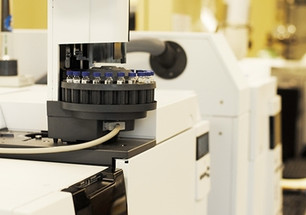Posted by Chrom Tech on 6th Nov 2025
What are the Benefits of Glass Vials in the Laboratory?
Chromatography vials are essential laboratory containers used to securely hold and transport samples before analysis by HPLC or GC systems. Whether made from glass or plastic, these vials play a critical role in ensuring sample integrity and analytical accuracy. But when selecting vials for your workflow, how do you determine whether glass or plastic is the right choice for your lab?
Benefits of Glass Vials
Glass is the most widely used material for chromatography vials—and for good reason. Chrom Tech’s glass autosampler vials are made from Type 1 borosilicate glass, a high-purity, chemically inert material often referred to as “neutral glass.” This makes it ideal for sensitive analytical applications where sample contamination must be avoided.
- Chemical Neutrality: Borosilicate glass resists leaching, ensuring that sample composition remains unaltered during storage or analysis.
- Heat Resistance: Glass vials can withstand temperatures exceeding 500 °C, making them suitable for heat-intensive laboratory processes.
- Analytical Purity: The inert nature of glass minimizes interaction with solvents and analytes, ensuring accurate, reproducible chromatographic results.
For most applications, glass vials are the preferred option due to their stability, chemical compatibility, and ability to handle high temperatures without distortion or degradation.
Benefits of Plastic Vials
While glass vials dominate most analytical workflows, plastic vials offer several advantages depending on the application. Polypropylene (PP) is the most common plastic vial material—it’s durable, translucent, and chemically compatible with most HPLC solvents. These vials are often chosen as a more economical option for limited-volume or routine analyses.
Other available plastics include:
- Polyethylene (PE): Suitable for acids, alcohols, and bases, but incompatible with solvents like benzene, chlorobenzene, and acetic anhydride.
- TPX Polymethylpentene: Offers superior chemical and heat resistance compared to PP or PE vials, making it ideal for challenging applications.
Plastic vials are lightweight, shatter-resistant, and often chosen for high-throughput labs seeking cost-effective alternatives to glass—especially when sample purity requirements are less stringent.
Clear vs. Amber (or Black) Vials
Most laboratories use clear vials—whether glass or plastic—because they allow for easy visual inspection of sample volume and clarity. However, for light-sensitive samples, amber or black vials are the preferred choice. These darker vials block UV and visible light, protecting sensitive analytes from photodegradation during storage and handling.
Other Key Considerations When Choosing a Chromatography Vial
In addition to material and color, several other factors should guide your vial selection:
- Autosampler Compatibility: Most autosamplers use standard 12 × 32 mm vials, but it’s essential to verify compatibility with your instrument before ordering.
- Sample Volume: Choose a vial size that matches your available sample quantity to minimize waste and optimize injection consistency.
- Closure Type: Select the appropriate cap and septa combination to ensure a secure seal and prevent sample evaporation or contamination.
At Chrom Tech, we supply a wide range of chromatography vials in both glass and plastic formats, with multiple closure and color options to fit every laboratory’s needs. For help selecting the best vial for your workflow, contact our sales team for personalized guidance.
Explore the science behind vial selection. Visit the Chromatography Vials hub to learn more.
Frequently Asked Questions About Chromatography Vials
What are chromatography vials used for?
Chromatography vials store and transport samples prior to analysis by HPLC or GC. They ensure sample integrity, prevent contamination, and are available in glass or plastic to suit different chemical and thermal requirements.
When should I choose glass vials over plastic vials?
Glass vials are preferred for sensitive or high-temperature applications due to their purity, chemical resistance, and heat stability. Plastic vials are better suited for cost-sensitive or limited-volume analyses.
Why use amber or black vials?
Amber and black vials protect light-sensitive samples from degradation caused by UV or visible light exposure, ensuring analyte stability during storage and analysis.

